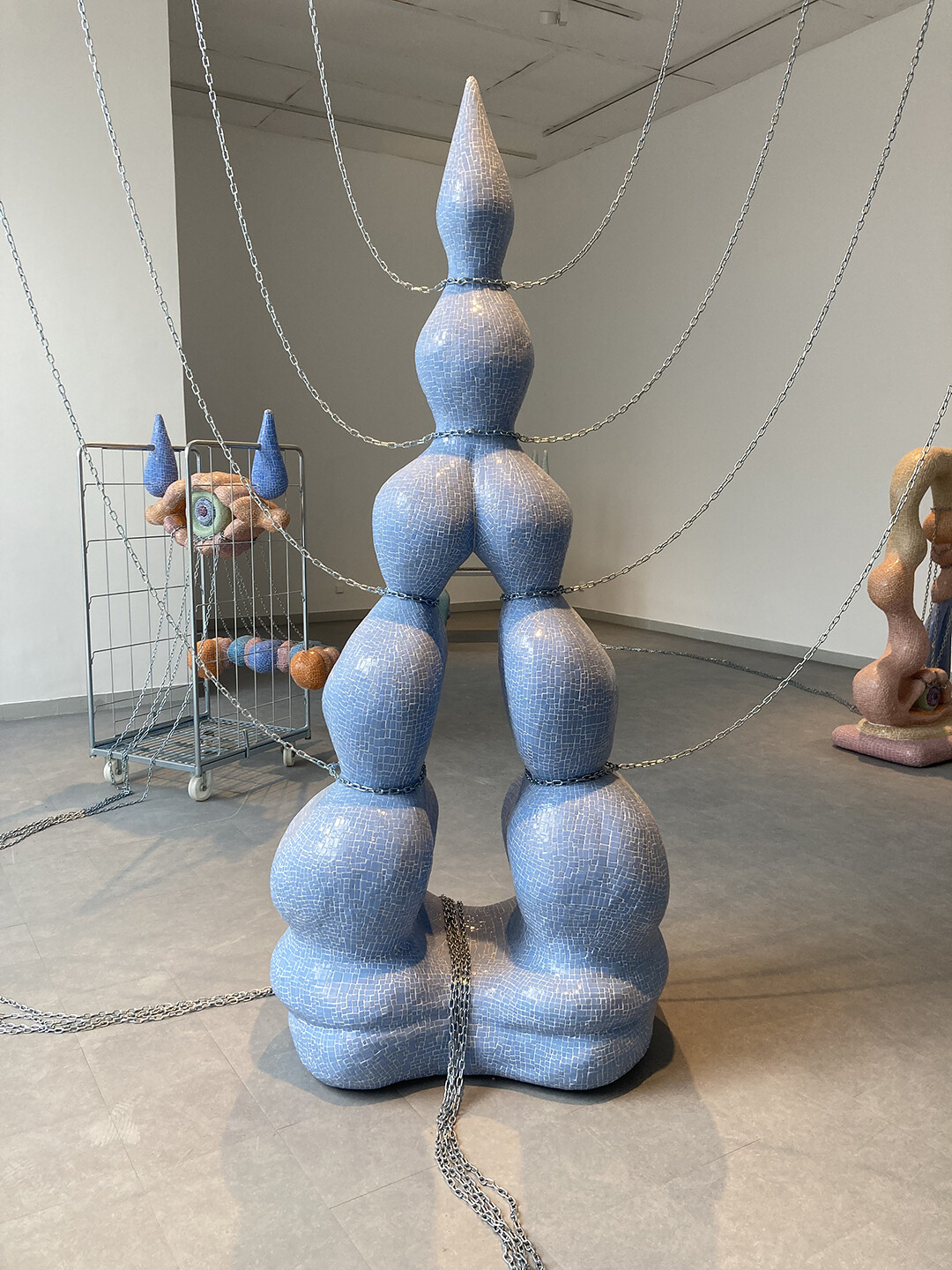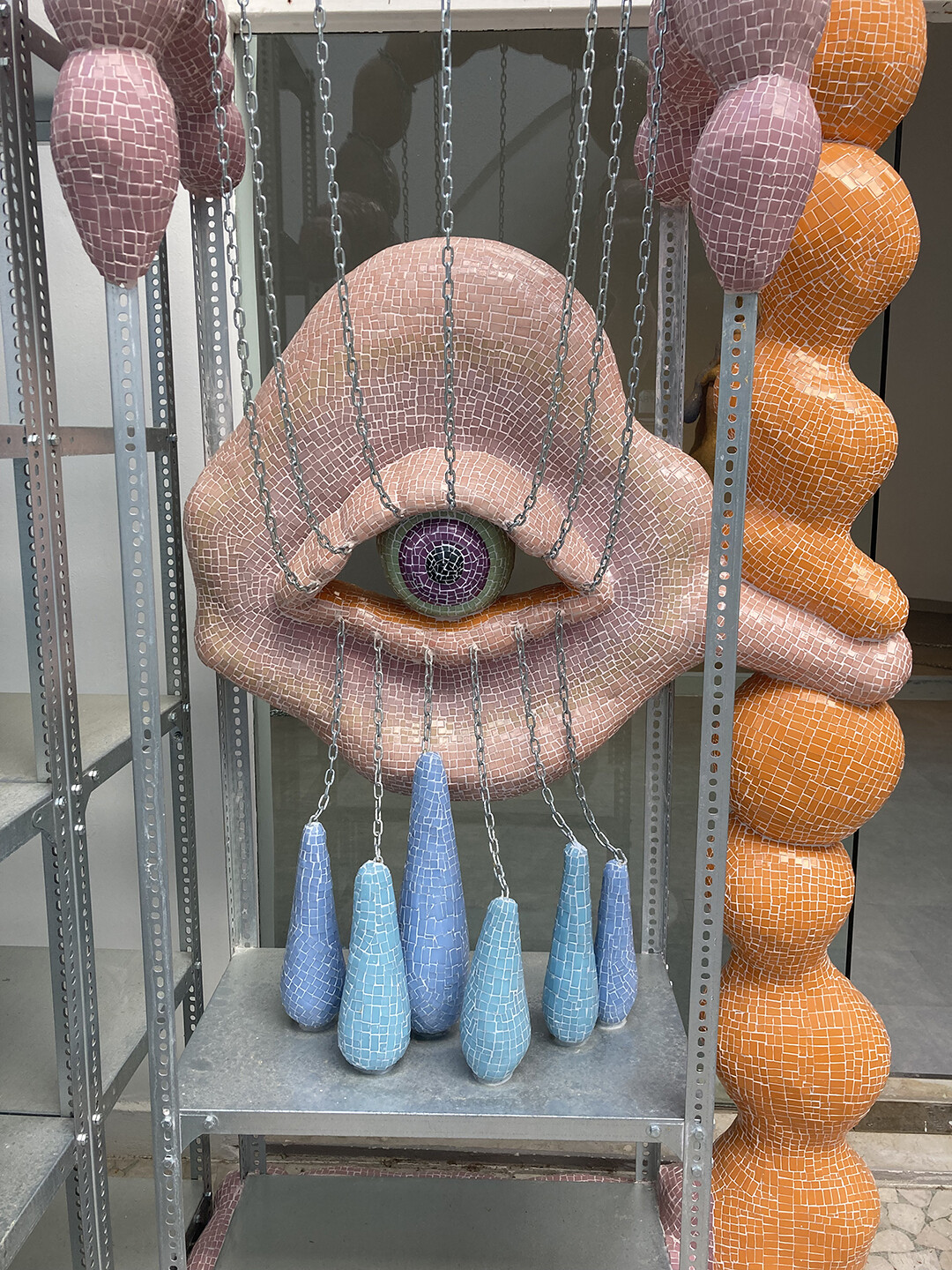Field Notes: Zsófia Keresztes, “After Dreams: I Dare to Defy the Damage,” Hungarian Pavilion, 59th Venice Biennale
by Camille Moreno
Identity is a curious concept. As many badges as it may acquire—titles, scars, markers of status—its true character lies somewhere in the intangible. Try as one might to determine its origin, identity is too multifaceted to locate a single source. The assembled or accumulated fragments of identity, however, can form a powerful composition, and this kind of fractured unity informs the visual language Zsófia Keresztes uses in her work, which spans architecture, mosaic, installation, and mythology. “After Dreams: I Dare to Defy the Damage,” Keresztes’s presentation at the Hungarian Pavilion—she is the third female artist to represent Hungary in its 110-year history at the Venice Biennale—prescribes an antidote to the cyclical patterns of pain and comfort that attend the human compulsion to bracket oneself inside of an identity, particularly within the framework of interpersonal intimacy.
Keresztes’s installation was inspired by an episode of self-realization in Antal Szerb’s Journey by Moonlight (1937) in which the protagonist takes in the ancient mosaics of Ravenna, the birthplace of the Byzantine mosaic technique. Newly wed yet desolately withdrawn, Mihály grapples with the parameters of his new identity as a married man and his deep disappointment in discovering that marriage is, in fact, neither a cure for loneliness nor existential turmoil. His fickle behavior exemplifies Arthur Schopenhauer’s “porcupine dilemma,” a metaphor adopted by Sigmund Freud to describe human’s simultaneous attraction to and repulsion from the quest for love. As porcupines try to stay warm, they come close enough to generate heat but must maintain enough distance to avoid injury from one another’s quills. (1)
Sensual, creatural, and commanding, Keresztes’s mosaics seize the imagination. Falling between figuration and abstraction, the obscure bulbous forms, whose clean lines and scintillating skins adorn their bizarre, undulating shapes, evade classification as either. Identifiable elements emerge—tear drops, eyes, bodies—only to morph into unrecognizable entities, some vaguely vulvic but most ponderously anonymous. When curator Mónika Zsikla submitted the proposal for “After Dreams: I Dare to Defy the Damage” to the Hungarian Selection Committee in 2020, the Venice Biennale’s chief curator Cecelia Alemani had not yet announced the central theme of “The Milk of Dreams” nor disclosed its motifs of bodies and their transfigured or surreal representations. The resonance of “After Dreams” with Alemani’s curatorial objectives is fortuitous but by no means accidental. Keresztes’s examination of female identity and the individual’s unresolved relationship to the other overlaps with core themes of “The Milk of Dreams” and makes evident the timeliness of the greater collective appraisal of the social construction of bodies and identities. Kerestezs illustrates the fluidity of identity in her work alongside the collaborative nature of identity construction and validation, which is rooted in a psychological perception that people are social beings. The role that human beings play in one another’s identity conception has led to an increasing awareness of the diverse representations of identities and the bodies they inhabit. This collaboration underpins a global creative discourse and lays bare the collective quest for the origins of identity that coincides with the Biennale’s prompt to reconceive the definition of the human and map its evolutions. Collaboration, however, may not always be conscious and thereby raises the question: Just how intuitive is synchronicity?
Synchronized identity construction can be observed in the digital realm and the collective coping mechanisms of a society besotted with solitude after global lockdowns and years of social distancing. Like porcupines, humans were forced to negotiate the risks of closeness and the costs of intimacy. Physical connection has become both a source of desire and dread, with one outlet for contact being virtuality, where intimacy comes with a click. In this space identities can be easily constructed, deconstructed, and edited to precision in what Zsikla equates to a “virtual crucible” where every unit of intimacy is captured and tracked. Keresztes visualizes physical-to-digital migration through a sculptural narrative that is linked by a network of heavy, industrial chains. In addition to symbolizing one’s burden, dependency, and acclimation to being locked inside oneself, the chain represents the matrix of the virtual world and the inescapable connectedness entailed in online identities.
The Hungarian Pavilion wraps around a central courtyard, and each of its rooms unfolds onto a sequence of sculptures that represent various stages of the pursuit of identity. Keresztes’s sculptures assume a more-than human scale and are made from expanded polystyrene and fiberglass bases covered with hand-cut mosaic tesserae in a creamy palette. The steely chain glimmers like lustrous jewelry draped across the décolletages of these uncanny forms. The work also engages associations with ancient mosaic methodology and the pixelated structure of the digital aesthetic, pointing to the intrinsic mosaic quality of digital images. (2) Similar tessellations can be observed in the consciousness of the self, which cannot be seen outright in its entirety, even by its host body. Particularly of interest to Keresztes is the foundation of identity being built from fragments of the past, which is transmitted through the relationship of her sculptures to the history of the physical structure. The pavilion by Géza Rintel Moróti was the third built in the Giardini, and since its construction in 1909, the building has undergone multiple renovations, notably the covering and subsequent uncovering of its original mosaics, which were executed by the prominent Hungarian mosaicist Mikes Róth. (3) The silent dialogue between the new mosaics and the old argues for the consecration of the pavilion’s own historical identity, as well as that of the mosaic medium.
Keresztes’s mosaics are technically immaculate, and they satisfy a contemporary desire for the handmade in what is nowadays something of a lost art and generally categorized as decorative or antique. Ancient Byzantine mosaic practice employs andamento, an Italian word that describes the movement or collective gesture created by the lines of the tesserae. It alludes to the way the pieces flow together and the cumulative force they convey by way of multiple, small, repeated relationships. Andamento has no direct English translation, no textbook representation, but when you see it, you know it, and Keresztes’s work has it. The architectural origins of ancient mosaics recur in these contemporary sculptures, the bodies of which resemble buildings or even entire cities but equally portray organs, limbs, or engorged digits.
With no designated start or finish, the exhibition’s layout invites the visitor to create their own sequences, alluding to a synergetic materialization of a rhizome as well as the mosaics’ structure and the forms of Keresztes’s works. Rhizomes are networks of multiplicities that defy conventional categorization, and as a map, the rhizome can be entered at any point as it continues indefinitely. There is no central root or logical pattern but rather a non-hierarchal accumulation, or lattice, that connects everything to everything else. (4) The multifaceted surfaces of Keresztes’s sculptures reflect or absorb light, depending on the time of day, and their play with the environmental phenomena of the pavilion’s fenestration creates the effect that the works are continually gathering and transmitting information about their surroundings. (5) This reactive presence gives the installation a sentient quality, defying the solidity of its own identity and inviting the viewer to do the same.
(1) Arthur Schopenhauer and R. J, Hollingdale, Essays and Aphorisms (London: Penguin Books, 1970), 801, →.
(2) Meredith Hoy, From Point to Pixel: A Genealogy of Digital Aesthetics (Hanover, N.H.: Dartmouth College Press, 2017), 41, →.
(3) Ludwig Múzeum “History of the Hungarian Pavilion, Venice, Giardini di Castello,” →.
(4) Gilles Deleuze and Felix Guattari, A Thousand Plateaus, (London: Bloomsbury Revelations and Bloomsbury Academic, 2013), →.
(5) Mónika Zsikla, After Dreams: I Dare to Defy the Damage, exhibition catalog (Budapest: Ludwig Múzeum, 2022), 11.
Field Notes is a series of reviews from the next generation of art writers. Featuring texts on the 59th Venice Biennale and Documenta 15 contributed by students and recent graduates, Field Notes makes original connections between the work and the world and takes a closer look at what other observers might have missed.



